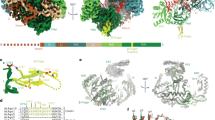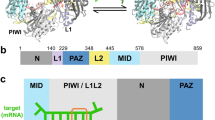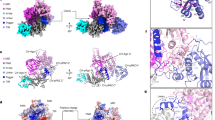Abstract
The slicer activity of the RNA-induced silencing complex resides within its Argonaute (Ago) component, in which the PIWI domain provides the catalytic residues governing guide-strand mediated site-specific cleavage of target RNA. Here we report on structures of ternary complexes of Thermus thermophilus Ago catalytic mutants with 5′-phosphorylated 21-nucleotide guide DNA and complementary target RNAs of 12, 15 and 19 nucleotides in length, which define the molecular basis for Mg2+-facilitated site-specific cleavage of the target. We observe pivot-like domain movements within the Ago scaffold on proceeding from nucleation to propagation steps of guide–target duplex formation, with duplex zippering beyond one turn of the helix requiring the release of the 3′-end of the guide from the PAZ pocket. Cleavage assays on targets of various lengths supported this model, and sugar-phosphate-backbone-modified target strands showed the importance of structural and catalytic divalent metal ions observed in the crystal structures.
This is a preview of subscription content, access via your institution
Access options
Subscribe to this journal
Receive 51 print issues and online access
$199.00 per year
only $3.90 per issue
Buy this article
- Purchase on Springer Link
- Instant access to full article PDF
Prices may be subject to local taxes which are calculated during checkout





Similar content being viewed by others
Accession codes
Primary accessions
Protein Data Bank
Data deposits
The structures of ternary complexes of T. thermophilus Ago have been submitted to the Protein Data Bank. The accession codes are: 3HO1 (mutant Ago(Asn 546)–12-nucleotide target RNA), 3HJF (mutant Ago(Glu 546)–15-nucleotide target RNA), 3HK2 (mutant Ago(Asn 478)–19-nucleotide target RNA), 3HM9 (wild-type Ago–19-nucleotide target RNA, 50mMMg), 3HVR (wild-type Ago–19-nucleotide target RNA, 80mM Mg), and 3HXM (second crystal form of wild-type Ago–20-nucleotide target RNA containing twomismatches31).
References
Dykxhoorn, D. M., Novina, C. D. & Sharp, P. A. Killing the messenger: short RNAs that silence gene expression. Nature Rev. Mol. Cell Biol. 4, 457–467 (2003)
Baulcombe, D. RNA silencing in plants. Nature 431, 356–363 (2004)
Meister, G. & Tuschl, T. Mechanisms of gene silencing by double-stranded RNA. Nature 431, 343–349 (2004)
Tomari, Y. & Zamore, P. D. Perspective: machines for RNAi. Genes Dev. 19, 517–529 (2005)
Filipowicz, W., Jaskiewicz, L., Kolb, F. A. & Pillai, R. S. Post-transcriptional gene silencing by siRNAs and miRNAs. Curr. Opin. Struct. Biol. 15, 331–341 (2005)
Hutvagner, G. & Simard, M. J. Argonaute proteins: key players in RNA silencing. Nature Rev. Mol. Cell Biol. 9, 22–32 (2008)
Kim, V. N., Han, J. & Siomi, M. C. Biogenesis of small RNAs in animals. Nature Rev. Mol. Cell Biol. 10, 126–139 (2009)
Carthew, R. W. & Sontheimer, E. J. Origins and mechanisms of miRNAs and siRNAs. Cell 136, 642–655 (2009)
Song, J. J., Smith, S. K., Hannon, G. J. & Joshua-Tor, L. Crystal structure of argonaute and its implications for RISC slicer activity. Science 305, 1434–1437 (2004)
Parker, J. S., Roe, S. & Barford, D. Crystal structure of a PIWI protein suggests mechanisms for siRNA recognition and slicer activity. EMBO J. 23, 4727–4737 (2004)
Yuan, Y. R. et al. Crystal structure of A. aeolicus argonaute, a site-specific DNA-guided endoribonuclease, provides insights into RISC-mediated mRNA cleavage. Mol. Cell 19, 405–419 (2005)
Liu, J. et al. Argonaute2 is the catalytic engine of RNAi. Science 305, 1437–1441 (2004)
Rivas, F. V. et al. Purified Ago2 and an siRNA form recombinant human RISC. Nature Struct. Biol. 12, 340–349 (2005)
Parker, J. S., Roe, S. M. & Barford, D. Structural insights into mRNA recognition from a PIWI domain-siRNA guide complex. Nature 434, 663–666 (2005)
Ma, J.-B. et al. Structural basis for 5′-end-specific recognition of guide RNA by the A. fulgidus Piwi protein. Nature 434, 666–670 (2005)
Ma, J.-B., Ye, K. & Patel, D. J. Structural basis for overhang-specific small interfering RNA recognition by the Paz domain. Nature 429, 318–322 (2004)
Lingel, A., Simon, B., Izaurralde, E. & Sattler, M. Nucleic acid 3′-end recognition by the Argonaute2 Paz domain. Nature Struct. Biol. 11, 576–577 (2004)
Martinez, J. & Tuschl, T. RISC is a 5′-phosphomonoester-producing RNA endonuclease. Genes Dev. 18, 975–980 (2004)
Schwarz, D. S., Tomari, Y. & Zamore, P. D. The RNA-induced silencing complex is a Mg2+-dependent endonuclease. Curr. Biol. 14, 787–791 (2004)
Elbashir, S. M., Lendeckel, W. & Tuschl, T. RNA interference is mediated by 21- and 22-nucleotide RNAs. Genes Dev. 15, 188–200 (2001)
Ameres, S. L., Martinez, J. & Schroeder, R. Molecular basis for target RNA recognition and cleavage by human RISC. Cell 130, 101–112 (2007)
Rana, T. M. Illuminating the silence: understanding the structure and function of small RNAs. Nature Rev. Mol. Cell Biol. 8, 23–36 (2007)
Parker, J. S. et al. Enhancement of the seed-target recognition step in RNA silencing by a PIWI/MID domain protein. Mol. Cell 33, 204–214 (2009)
Parker, J. S. & Barford, D. Argonaute: a scaffold for the function of short regulatory RNAs. Trends Biochem. Sci. 31, 622–630 (2006)
Patel, D. J. et al. Structural biology of RNA silencing and its functional implications. Cold Spring Harb. Symp. Quant. Biol. 71, 81–93 (2006)
Tolia, N. H. & Joshua-Tor, L. Slicer and the argonautes. Nature Chem. Biol. 3, 36–43 (2007)
Jinek, M. & Doudna, J. A three-dimensional view of the molecular machinery of RNA interference. Nature 457, 405–412 (2009)
de Fougerolles, A., Vornlocher, H.-P., Maraganore, L. & Lieberman, J. Interfering with disease: a progress report on siRNA-based therapeutics. Nature Rev. Drug Discov. 6, 443–453 (2007)
Castanotto, D. & Rossi, J. J. The promises and pitfalls of RNA-interference based therapeutics. Nature 457, 426–433 (2009)
Wang, Y. et al. Structure of the guide-strand-containing argonaute silencing complex. Nature 456, 209–213 (2008)
Wang, Y. et al. Structure of an argonaute silencing complex with a seed-containing guide DNA and target RNA duplex. Nature 456, 921–926 (2008)
Mi, S. et al. Sorting of small RNAs into Arabidopsis argonaute complexes is directed by the 5′-terminal nucleotide. Cell 133, 116–127 (2008)
Montgomery, T. A. et al. Specificity of ARGONAUTE7-miR390 interaction and dual functionality in TAS3 trans-acting siRNA formation. Cell 133, 128–141 (2008)
Filipowicz, W. The nuts and bolts of the RISC machine. Cell 122, 17–20 (2005)
Chi, S. W., Zang, J. B., Mele, A. & Darnell, R. B. Argonaute HITS-CLIP decodes microRNA-mRNA interaction maps. Nature 460, 479–486 (2009)
Nowotny, M., Gaidamakov, S. A., Crouch, R. J. & Yang, W. Crystal structures of RNase H bound to an RNA/DNA hybrid: Substrate specificity and metal-dependent catalysis. Cell 121, 1005–1016 (2005)
Nowotny, M. Retroviral integrase superfamily: the structural perspective. EMBO Rep. 10, 144–151 (2009)
Turner, D. H. Thermodynamics of base pairing. Curr. Opin. Struct. Biol. 6, 299–304 (1996)
Freier, S. M. & Altmann, K. H. The ups and downs of nucleic acid duplex stability: structure-stability studies on chemically-modified DNA:RNA duplexes. Nucleic Acids Res. 25, 4429–4443 (1997)
Verma, S. & Eckstein, F. Modified oligonucleotides: synthesis and strategy for users. Annu. Rev. Biochem. 67, 99–134 (1998)
Otwinowski, Z. & Minor, W. Processing of X-ray diffraction data collected in oscillation mode. Meth. Enzymol. 276, 307–326 (1997)
McCoy, A. J. et al. Phaser crystallographic software. J. Appl. Crystallogr. 40, 658–674 (2007)
Emsley, P. & Cowtan, K. Coot: model-building tools for molecular graphics. Acta Crystallogr. D 60, 2126–2132 (2004)
Brünger, A. T. et al. Crystallography & NMR system: A new software suite for macromolecular structure determination. Acta Crystallogr. D 54, 905–921 (1998)
Adams, P. D. et al. PHENIX: building new software for automated crystallographic structure determination. Acta Crystallogr. D 58, 1948–1954 (2002)
Tonelli, M. et al. Dynamic NMR structures of [RP]- and [SP]-phosphorothioated DNA-RNA hybrids: is flexibility required for RNase H recognition? Biophys. J. 85, 2525–2538 (2003)
Thorogood, H., Grasby, J. A. & Connolly, B. A. Influence of the phosphate backbone on the recognition and hydrolysis of DNA by the EcoRV restriction endonuclease. A study using oligodeoxynucleotide phosphorothioates. J. Biol. Chem. 271, 8855–8862 (1996)
Burgers, P. M. & Eckstein, F. Absolute configuration of the diastereomers of adenosine 5′-O-(1-thiotriphosphate): consequences for the stereochemistry of polymerization by DNA-dependent RNA polymerase from Escherichia coli . Proc. Natl Acad. Sci. USA 75, 4798–4800 (1978)
Acknowledgements
The research was supported by funds from the National Institutes of Health (NIH) and the Starr Foundation to D.J.P., and from the NIH, Starr Foundation and the Howard Hughes Medical Institute (HHMI) to T.T. We would like to thank the staff of NE-CAT beam lines at the Advanced Photon Source (APS), Argonne National Laboratory, and the X-29 beamline at the Brookhaven National Laboratory, supported by the US Department of Energy, for assistance with data collection. We thank Z. Wang for assistance with X-ray data collection at the APS.
Author Contributions Y.W. and G.S. expressed and purified wild-type T. thermophilus Ago and its catalytic mutants, and also grew crystals of the various ternary complexes. H.L. collected X-ray diffraction data on the various NE-CAT beam lines, and Y.W. solved the structures of these ternary complexes. D.J.P. supervised the structural studies. S.J. was responsible for the cleavage assays on Ago with modified DNA and RNA target strands, and G.S.W. purified the phosphorothioate diastereomers and quality controlled oligonucleotides, under the supervision of T.T. D.J.P. and T.T. were primarily responsible for writing the structural and biochemical contents of the paper, respectively, and all authors read and approved the submitted manuscript.
Author information
Authors and Affiliations
Corresponding authors
Ethics declarations
Competing interests
[COMPETING INTERESTS: T.T. is a cofounder and scientific advisor to Alnylam Pharmaceuticals and an advisor to Regulus Therapeutics.]
Supplementary information
Supplementary Information
This file contains Supplementary Notes, Supplementary Tables 1-4 and Supplementary Figures 1-27 with Legends. (PDF 10468 kb)
Supplementary Movie 1
This movie shows interconversion between Ago binary complex containing guide DNA (in red) and Ago ternary complex containing added 12-nucleotide target RNA (in blue). (AVI 3932 kb)
Supplementary Movie 2
This movie shows interconversion between Ago ternary complexes containing guide DNA (in red) and added 12- and 15-nucleotide target RNAs (in blue). (AVI 3704 kb)
Supplementary Movie 3
This movie shows rotation of Ago ternary complex structure containing guide DNA (in red) and 19-nucleotide target RNA (in blue). (AVI 13088 kb)
Rights and permissions
About this article
Cite this article
Wang, Y., Juranek, S., Li, H. et al. Nucleation, propagation and cleavage of target RNAs in Ago silencing complexes. Nature 461, 754–761 (2009). https://doi.org/10.1038/nature08434
Received:
Accepted:
Issue Date:
DOI: https://doi.org/10.1038/nature08434
This article is cited by
-
Unlocking the potential of RNAi as a therapeutic strategy against infectious viruses: an in-silico study
Chemical Papers (2024)
-
Efficient manipulation of gene expression using Natronobacterium gregoryi Argonaute in zebrafish
BMC Biology (2023)
-
microRNAs in action: biogenesis, function and regulation
Nature Reviews Genetics (2023)
-
Oligomerization-mediated activation of a short prokaryotic Argonaute
Nature (2023)
-
Determining the defining lengths between mature microRNAs/small interfering RNAs and tinyRNAs
Scientific Reports (2023)
Comments
By submitting a comment you agree to abide by our Terms and Community Guidelines. If you find something abusive or that does not comply with our terms or guidelines please flag it as inappropriate.



